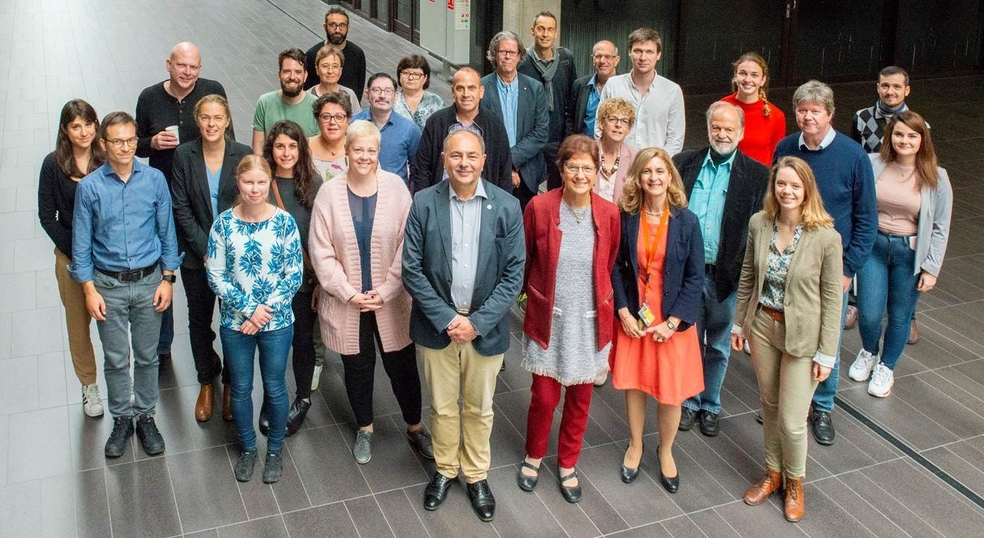Proof-of-concept that network pharmacology is effective to modify development of acquired temporal lobe epilepsy
In: Neurobiology of Disease, 2019. doi: 10.1016/j.nbd.2019.104664
Alina Schidlitzki a,b,1, Pablo Bascuñana c,1, Prashant K. Srivastava d, Lisa Welzel a,b, Friederike Twele a, Kathrin Töllner a, Christopher Käufer a, Birthe Gericke a,b, Rahel Feleke d, Martin Meier e, Andras Polyak c, Tobias L. Ross c, Ingo Gerhauser f, Jens P. Bankstahl c, Michael R. Johnson d, Marion Bankstahl a,b,e, Wolfgang Löscher a,b,2
a Department of Pharmacology, Toxicology, and Pharmacy, University of Veterinary Medicine Hannover, 30559 Hannover, Germany
b Center for Systems Neuroscience, 30559 Hannover, Germany
c Department of Nuclear Medicine, Hannover Medical School, Germany
d Division of Brain Sciences, Imperial College London, London, UK
e Central Animal Facility & Institute for Laboratory Animal Science, Hannover Medical School, Hannover, Germany
f Department of Pathology, University of Veterinary Medicine Hannover, Germany
“Network pharmacology” is a polypharmacy strategy to design therapies that act on several targets in a complex disease network. Here we evaluated the potential of this strategy to prevent or modify development of epilepsy after brain injury, which is a major unmet clinical need. In silico analysis of drug-protein interaction networks indicated that a combination of a presynaptically acting (levetiracetam) with a postsynaptically acting drug (topiramate) alters multiple targets thought to be involved in epileptogenesis. In vivo evaluation of this drug combination in a widely used mouse model of acquired epilepsy demonstrated significant antiepileptogenic and disease-modifying efficacy, thus substantiating the in silico prediction. In contrast, either drug alone was not effective, providing proof-of-concept of the superiority of the network approach.
Computing Hubs in the Hippocampus and Cortex
In: Science Advances, 2019. doi: 10.1126/sciadv.aax4843
Wesley Clawson, Ana F. Vicente, Maëva Ferraris, Christophe Bernard*, Demian Battaglia*,† and Pascale P. Quilichini *,†
Aix Marseille Univ, Inserm, INS, Institut de Neurosciences des Systèmes, Marseille, France.
†Corresponding author. Email: demian.battaglia@univ-amu.fr (D.B.); pascale.quilichini@univ-amu.fr (P.P.Q.)
* These authors contributed equally as last authors.
Neural computation occurs within large neuron networks in the dynamic context of varying brain states. Whether functions are performed by specific subsets of neurons and whether they occur in specific dynamical regimes remain poorly understood. Using high-density recordings in the hippocampus, medial entorhinal, and medial prefrontal cortex of the rat, we identify computing substates where specific computing hub neurons perform well-defined storage and sharing operations in a brain state–dependent manner. We retrieve distinct computing substates within each global brain state, such as REM and nonREM sleep. Half of recorded neurons act as computing hubs in at least one substate, suggesting that functional roles are not hardwired but reassigned at the second time scale. We identify sequences of substates whose temporal organization is dynamic and stands between order and disorder. We propose that global brain states constrain the language of neuronal computations by regulating the syntactic complexity of substate sequences.
Effects of Single-cage Housing on Stress, Cognitive and seizure Parameters in the Rat and Mouse Models of Epilepsy
In eNeuro, 2019. doi: 10.1523/ENEURO.0179-18.2019
This article has been featured in Science Editor's Choice of August 16th, 2019.
Houria Manouze1,2, Antoine Ghestem1, Victoria Poillerat3, Mohamed Bennis2, Saadia Ba-M’hamed2, Jean-Jacques Benoliel3,4, Christel Becker3, and Christophe Bernard5
1 Aix Marseille University, Inserm, INS, Institut de Neurosciences des Systèmes, Marseille, France.
2 Laboratory of Pharmacology, Neurobiology and Behavior (URAC-37), Cadi Ayyad University, Marrakech, Morocco.
3 Université Paris Descartes - Université de Paris, UFR des Sciences Fondamentales et Biomédicales, INSERM UMRS 1124, Paris F-75006, France.
4 Service de Biochimie Endocrinienne et Oncologique, AP-HP, Hôpital de la Pitié-Salpêtrière, Paris F-75013, France.
5 Aix Marseille Univ, Inserm, INS, Institut de Neurosciences des Systèmes, Marseille, France christophe.bernard@univ-amu.fr.
Many experimental approaches require housing rodents in individual cages, including in epilepsy research. However, rats and mice are social animals; and individual housing constitutes a stressful situation. The goal of the present study was to determine the effects of individual housing as compared to conditions maintaining social contact on stress markers and epilepsy. Control male mice socially housed during pretest and then transferred to individual cages for six weeks displayed anhedonia, increased anxiety and biological markers of stress as compared to pretest values or mice kept socially housed during six weeks. Pilocarpine (pilo)-treated mice housed together showed increased levels of anhedonia, anxiety and stress markers as well as decreased cognitive performance as compared to the control group. The differences were more significant in pilo-treated mice housed individually. Anxiety correlated linearly with cognitive performance and stress markers independently of the experimental conditions. In the male rat pilo model, seizures were sixteen times more frequent in singly housed animals as compared to animals kept in pairs. Daily interactions with an experimenter in otherwise singly housed animals was sufficient to produce results identical to those found in animals kept in pairs. We propose that social isolation produces a severe phenotype in terms of stress and seizure frequency as compared to animals maintaining social contact (at least in these two models), a factor that needs to be taken into account for data interpretation, in particular for preclinical studies.
Coding and non-coding transcriptome of mesial temporal lobe epilepsy: Critical role of small non-coding RNAs.
In: Neubiology of Disease, 2019. doi: 10.1016/j.nbd.2019.104612
Mills JD1, van Vliet EA2, Chen BJ3, Janitz M3, Anink JJ1, Baayen JC4, Idema S4, Devore S5, Friedman D5, Diehl B6, Thom M6, Scott C6, Thijs R7, Aronica E8, Devinsky O9.
1 Amsterdam UMC, University of Amsterdam, Department of (Neuro)Pathology, Amsterdam Neuroscience, Meibergdreef 9, Amsterdam, the Netherlands.
2 Amsterdam UMC, University of Amsterdam, Department of (Neuro)Pathology, Amsterdam Neuroscience, Meibergdreef 9, Amsterdam, the Netherlands; Swammerdam Institute for Life Sciences, Center for Neuroscience, University of Amsterdam, Amsterdam, the Netherlands.
3 School of Biotechnology and Biomolecular Sciences, University of New South Wales, Sydney, New South Wales, Australia.
4 Amsterdam UMC, Vrije Universiteit Amsterdam, Department of Neurosurgery, Amsterdam Neuroscience, De Boelelaan 1117, Amsterdam, the Netherlands.
5 Comprehensive Epilepsy Center, New York University Langone Medical Center, New York, NY, USA.
6 Department of Clinical and Experimental Epilepsy, University College London Institute of Neurology, London, UK.
7 Stichting Epilepsie Instellingen Nederland (SEIN), Heemstede, the Netherlands.
8 Amsterdam UMC, University of Amsterdam, Department of (Neuro)Pathology, Amsterdam Neuroscience, Meibergdreef 9, Amsterdam, the Netherlands; Stichting Epilepsie Instellingen Nederland (SEIN), Heemstede, the Netherlands.
9 Comprehensive Epilepsy Center, New York University Langone Medical Center, New York, NY, USA. Electronic address: od4@nyu.edu.
Our understanding of mesial temporal lobe epilepsy (MTLE), one of the most common form of drug-resistant epilepsy in humans, is derived mainly from clinical, imaging, and physiological data from humans and animal models. High-throughput gene expression studies of human MTLE have the potential to uncover molecular changes underlying disease pathogenesis along with novel therapeutic targets. Using RNA- and small RNA-sequencing in parrallel, we explored differentially expressed genes in the hippocampus and cortex of MTLE patients who had undergone surgical resection and non-epileptic controls. We identified differentially expressed genes in the hippocampus of MTLE patients and differentially expressed small RNAs across both the cortex and hippocampus. We found significant enrichment for astrocytic and microglial genes among up-regulated genes, and down regulation of neuron specific genes in the hippocampus of MTLE patients. The transcriptome profile of the small RNAs reflected disease state more robustly than mRNAs, even across brain regions which show very little pathology. While mRNAs segregated predominately by brain region for MTLE and controls, small RNAs segregated by disease state. In particular, our data suggest that specific miRNAs (e.g., let-7b-3p and let-7c-3p) may be key regulators of multiple pathways related to MTLE pathology. Further, we report a strong association of other small RNA species with MTLE pathology. As such we have uncovered novel elements that may contribute to the establishment and progression of MTLE pathogenesis and that could be leveraged as therapeutic targets.
microRNA-132 is overexpressed in glia in temporal lobe epilepsy and reduces the expression of pro-epileptogenic factors in human cultured astrocytes.
In: Glia, 2019. doi: 10.1002/glia.23700
Korotkov A1, Broekaart DWM1, Banchaewa L1, Pustjens B1, van Scheppingen J1, Anink JJ1, Baayen JC2, Idema S2, Gorter JA3, van Vliet EA1,3, Aronica E1,4.
1 Amsterdam UMC, University of Amsterdam, Department of (Neuro)Pathology, Amsterdam Neuroscience, Meibergdreef 9, Amsterdam, the Netherlands.
2 Amsterdam UMC, Vrije Universiteit Amsterdam, Department of Neurosurgery, Amsterdam Neuroscience, De Boelelaan 1117, Amsterdam, the Netherlands.
3 Swammerdam Institute for Life Sciences, Center for Neuroscience, University of Amsterdam, Amsterdam, the Netherlands.
4 Stichting Epilepsie Instellingen Nederland (SEIN), Heemstede, the Netherlands.
Temporal lobe epilepsy (TLE) is a chronic neurological disease in humans, which is refractory to pharmacological treatment in about 30% of the patients. Reactive glial cells are thought to play a major role during the development of epilepsy (epileptogenesis) via regulation of brain inflammation and remodeling of the extracellular matrix (ECM). These processes can be regulated by microRNAs (miRs), a class of small non-coding RNAs, which can control entire gene networks at a post-transcriptional level. The expression of miRs is known to change dynamically during epileptogenesis. miR-132 is one of the most commonly upregulated miRs in animal TLE models with important roles shown in neurons. However, the possible role of miR-132 in glia remains largely unknown. The aim of this study was to characterize the cell-type specific expression of miR-132 in the hippocampus of patients with TLE and during epileptogenesis in a rat TLE model. Furthermore, the potential role of miR-132 was investigated by transfection of human primary cultured astrocytes that were stimulated with the cytokines IL-1β or TGF-β1. We showed an increased expression of miR-132 in the human and rat epileptogenic hippocampus, particularly in glial cells. Transfection of miR-132 in human primary astrocytes reduced the expression of pro-epileptogenic COX-2, IL-1β, TGF-β2, CCL2, and MMP3. This suggests that miR-132, particularly in astrocytes, represents a potential therapeutic target that warrants further in vivo investigation.
Increased matrix metalloproteinases expression in tuberous sclerosis complex: modulation by microRNA 146a and 147b in vitro.
In: Neuropathology and Applied neurobiology, 2019. doi: 10.1111/nan.12572
Broekaart DWM1, van Scheppingen J1, Anink JJ1, Wierts L2,3, van Het Hof B3, Jansen FE4, Spliet WG5, van Rijen PC6, Kamphuis WW2,3, de Vries HE3, Aronica E1,7, van Vliet EA1,8.
1 Department of (Neuro)Pathology, Amsterdam Neuroscience, Amsterdam UMC, University of Amsterdam, Amsterdam, The Netherlands.
2 Brendinn Therapeutics, Amsterdam, The Netherlands.
3 Department of Molecular Cell Biology and Immunology, Amsterdam Neuroscience, Amsterdam UMC, Vrije Universiteit Amsterdam, Amsterdam, The Netherlands.
4 Department of Pediatric Neurology, University Medical Center Utrecht, Utrecht, The Netherlands.
5 Department of Pathology, University Medical Center Utrecht, Utrecht, The Netherlands.
6 Department of Neurosurgery, Rudolf Magnus Institute for Neuroscience, University Medical Center Utrecht, Utrecht, The Netherlands.
7 Stichting Epilepsie Instellingen Nederland (SEIN), Heemstede, The Netherlands.
8 Swammerdam Institute for Life Sciences, Center for Neuroscience, University of Amsterdam, Amsterdam, The Netherlands.
AIM: Matrix metalloproteinases (MMPs) and their endogenous tissue inhibitors (TIMPs) control proteolysis within the extracellular matrix (ECM) of the brain. Dysfunction of this enzymatic system due to brain inflammation can disrupt the blood-brain barrier (BBB) and has been implicated in the pathogenesis of epilepsy. However, this has not been extensively studied in the epileptogenic human brain.
METHODS: We investigated the expression and cellular localization of major MMPs (MMP2, MMP3, MMP9 and MMP14) and TIMPs (TIMP1, TIMP2, TIMP3 and TIMP4) using quantitative real-time polymerase chain reaction (RT-PCR) and immunohistochemistry in resected epileptogenic brain tissue from patients with tuberous sclerosis complex (TSC), a severe neurodevelopmental disorder characterized by intractable epilepsy and prominent neuroinflammation. Furthermore, we determined whether anti-inflammatory microRNAs, miR146a and miR147b, which can regulate gene expression at the transcriptional level, could attenuate dysregulated MMP and TIMP expression in TSC tuber-derived astroglial cultures.
RESULTS: We demonstrated higher mRNA and protein expression of MMPs and TIMPs in TSC tubers compared to control and perituberal brain tissue, particularly in dysmorphic neurons and giant cells, as well as in reactive astrocytes, which was associated with BBB dysfunction. More importantly, IL-1β-induced dysregulation of MMP3, TIMP2, TIMP3 and TIMP4 could be rescued by miR146a and miR147b in tuber-derived TSC cultures.
CONCLUSIONS: This study provides evidence of dysregulation of the MMP/TIMP proteolytic system in TSC, which is associated with BBB dysfunction. As dysregulated MMP and TIMP expression can be ameliorated in vitro by miR146a and miR147b, these miRNAs deserve further investigation as a novel therapeutic approach.
The Roof is Leaking and a Storm is Raging: Repairing the Blood-Brain Barrier in the Fight Against Epilepsy.
In: Epilepsy Currents, 2019. doi: 10.1177/1535759719844750
Gorter JA1, Aronica E2,3, van Vliet EA1,2.
1 Center for Neuroscience, Swammerdam Institute for Life Sciences, University of Amsterdam, Amsterdam, the Netherlands.
2 Department of (Neuro)pathology, Amsterdam UMC, University of Amsterdam, Amsterdam, the Netherlands.
3 Stichting Epilepsie Instellingen Nederland (SEIN), the Netherlands.
A large body of evidence that has accumulated over the past decade strongly supports the role of both blood-brain barrier (BBB) dysfunction and perivascular inflammation in the pathophysiology of epilepsy. Recent preclinical studies indicate that prolonged seizure- or brain injury-induced BBB dysfunction and subsequent perivascular inflammation may play an important role in post-traumatic epileptogenesis. In turn, perivascular inflammation can further sustain BBB dysfunction. In genetic epilepsies, such as tuberous sclerosis complex and other related epileptogenic developmental pathologies, there is an association between the underlying gene mutation, BBB dysfunction, and perivascular inflammation, but evidence for a causal link to epilepsy is lacking. Future neuroimaging studies might shed light on the role of BBB function in different epilepsies and address the potential for disease modification by targeting both the BBB and perivascular inflammation in acquired and genetic epilepsies.
Oxidative stress and inflammation in a spectrum of epileptogenic cortical malformations: molecular insights into their interdependence.
In: Brain Pathology, 2019. doi: 10.1111/bpa.12661
Arena A1,2, Zimmer TS1, van Scheppingen J1, Korotkov A1, Anink JJ1, Mühlebner A1, Jansen FE3, van Hecke W4, Spliet WG4, van Rijen PC5, Vezzani A6, Baayen JC7, Idema S7, Iyer AM1, Perluigi M2, Mills JD1, van Vliet EA1,8, Aronica E1,9.
1 Department of (Neuro-)Pathology, Amsterdam UMC, University of Amsterdam, Amsterdam Neuroscience, Meibergdreef 9, Amsterdam, the Netherlands.
2 Department of Biochemical Sciences, Sapienza University of Rome, Rome, Italy.
3 Department of Pediatric Neurology, University Medical Center Utrecht, Utrecht, the Netherlands.
4 Department of Pathology, University Medical Center Utrecht, Utrecht, the Netherlands.
5 Department of Neurosurgery, Rudolf Magnus Institute for Neuroscience, University Medical Center Utrecht, Utrecht, the Netherlands.
6 Department of Neuroscience, IRCCS-Istituto di Ricerche Farmacologiche "Mario Negri", Milan, Italy.
7 Department of Neurosurgery, Amsterdam Neuroscience, Amsterdam UMC, Vrije Universiteit Amsterdam, Amsterdam, the Netherlands.
8 Swammerdam Institute for Life Sciences, Center for Neuroscience, University of Amsterdam, Amsterdam, the Netherlands.
9 Stichting Epilepsie Instellingen Nederland (SEIN), the Netherlands.
Oxidative stress (OS) occurs in brains of patients with epilepsy and coincides with brain inflammation, and both phenomena contribute to seizure generation in animal models. We investigated whether expression of OS and brain inflammation markers co-occurred also in resected brain tissue of patients with epileptogenic cortical malformations: hemimegalencephaly (HME), focal cortical dysplasia (FCD) and cortical tubers in tuberous sclerosis complex (TSC). Moreover, we studied molecular mechanisms linking OS and inflammation in an in vitro model of neuronal function. Untangling interdependency and underlying molecular mechanisms might pose new therapeutic strategies for treating patients with drug-resistant epilepsy of different etiologies. Immunohistochemistry was performed for specific OS markers xCT and iNOS and brain inflammation markers TLR4, COX-2 and NF-κB in cortical tissue derived from patients with HME, FCD IIa, IIb and TSC. Additionally, we studied gene expression of these markers using the human neuronal cell line SH-SY5Y in which OS was induced using H2 O2 . OS markers were higher in dysmorphic neurons and balloon/giant cells in cortex of patients with FCD IIb or TSC. Expression of OS markers was positively correlated to expression of brain inflammation markers. In vitro, 100 µM, but not 50 µM, of H2 O2 increased expression of TLR4, IL-1β and COX-2. We found that NF-κB signaling was activated only upon stimulation with 100 µM H2 O2 leading to upregulation of TLR4 signaling and IL-1β. The NF-κB inhibitor TPCA-1 completely reversed this effect. Our results show that OS positively correlates with neuroinflammation and is particularly evident in brain tissue of patients with FCD IIb and TSC. In vitro, NF-κB is involved in the switch to an inflammatory state after OS. We propose that the extent of OS can predict the neuroinflammatory state of the brain. Additionally, antioxidant treatments may prevent the switch to inflammation in neurons thus targeting multiple epileptogenic processes at once.
Curcumin reduces development of seizurelike events in the hippocampal-entorhinal cortex slice culture model for epileptogenesis.
In: Epilepsia, 2019. doi: 10.1111/epi.14667
Drion CM1, Kooijman L1, Aronica E2,3, van Vliet EA1,2, Wadman WJ1, Chameau P1, Gorter JA1.
1 Center for Neuroscience, Swammerdam Institute for Life Sciences, University of Amsterdam, Amsterdam, The Netherlands.
2 Amsterdam UMC, University of Amsterdam, Department of (Neuro) Pathology, Amsterdam Neuroscience, Amsterdam, The Netherlands.
3 Stichting Epilepsie Instellingen Nederland (SEIN), The Netherlands.
OBJECTIVE: Inhibition of the mammalian target of rapamycin (mTOR) pathway could be antiepileptogenic in temporal lobe epilepsy (TLE), possibly via anti-inflammatory actions. We studied effects of the mTOR inhibitor rapamycin and the anti-inflammatory compound curcumin-also reported to inhibit the mTOR pathway-on epileptogenesis and inflammation in an in vitro organotypic hippocampal-entorhinal cortex slice culture model.
METHODS: Brain slices containing hippocampus and entorhinal cortex were obtained from 6-day-old rat pups and maintained in culture for up to 3 weeks. Rapamycin or curcumin was added to the culture medium from day 2 in vitro onward. Electrophysiological recordings revealed epileptiformlike activity that developed over 3 weeks.
RESULTS: In week 3, spontaneous seizurelike events (SLEs) could be detected using whole cell recordings from CA1 principal neurons. The percentage of recorded CA1 neurons displaying SLEs was lower in curcumin-treated slice cultures compared to vehicle-treated slices (25.8% vs 72.5%), whereas rapamycin did not reduce SLE occurrence significantly (52%). Western blot for phosphorylated-S6 (pS6) and phosphorylated S6K confirmed that rapamycin inhibited the mTOR pathway, whereas curcumin only lowered pS6 expression at one phosphorylation site. Real-time quantitative polymerase chain reaction results indicated a trend toward lower expression of inflammatory markers IL-1β and IL-6 and transforming growth factor β after 3 weeks of treatment with rapamycin and curcumin compared to vehicle.
SIGNIFICANCE: Our results show that curcumin suppresses SLEs in the combined hippocampal-entorhinal cortex slice culture model and suggest that its antiepileptogenic effects should be further investigated in experimental models of TLE.
SorCS2 Controls Functional Expression of Amino Acid Transporter EAAT3 and Protects Neurons from Oxidative Stress and Epilepsy-Induced Pathology
In: Cell Reports, 2019. doi: 10.1016/j.celrep.2019.02.027
Anna R. Malik1, Kinga Szydlowska2, Karolina Nizinska2, Antonino Asaro1, Erwin A. van Vliet3,4, Oliver Popp1, Gunnar Dittmar5, Raphaela Fritsche-Guenther1,6, Jennifer A. Kirwan1,6, Anders Nykjaer7, Katarzyna Lukasiuk2, Eleonora Aronica3,8, Thomas E. Willnow1,9
1 Max-Delbrueck-Center for Molecular Medicine, 13125 Berlin, Germany
2 Nencki Institute of Experimental Biology, Polish Academy of Sciences, 02-093 Warsaw, Poland
3 Department of (Neuro)Pathology, Academic Medical Center, University of Amsterdam, 1105AZ Amsterdam, the Netherlands
4 Swammerdam Institute for Life Sciences, University of Amsterdam, 1098 XH, Amsterdam, the Netherlands
5 Department of Oncology, Luxembourg Institute of Health, 1445 Strassen, Luxembourg
6 Berlin Institute of Health Metabolomics Platform, 10178 Berlin, Germany
7 MIND Center, Danish Research Institute of Translational Neuroscience - DANDRITE, The Danish Research Foundation Center PROMEMO, Departments of Biomedicine, Aarhus University, and Neurosurgery, Aarhus University Hospital, 8000C Aarhus, Denmark
8 Stichting Epilepsie Instellingen Nederland (SEIN), 2103 SW Heemstede, the Netherlands
VPS10P domain receptors emerge as central regulators of intracellular protein sorting in neurons with relevance for various brain pathologies. Here, we identified a role for the family member SorCS2 in protection of neurons from oxidative stress and epilepsy-induced cell death. We show that SorCS2 acts as sorting receptor that sustains cell surface expression of the neuronal amino acid transporter EAAT3 to facilitate import of cysteine, required for synthesis of the reactive oxygen species scavenger glutathione. Lack of SorCS2 causes depletion of EAAT3 from the plasma membrane and impairs neuronal cysteine uptake. As a consequence, SorCS2-deficient mice exhibit oxidative brain damage that coincides with enhanced neuronal cell death and increased mortality during epilepsy. Our findings highlight a protective role for SorCS2 in neuronal stress response and provide a possible explanation for upregulation of this receptor seen in surviving neurons of the human epileptic brain.
GSK3β activity alleviates epileptogenesis and limits GluA1 phosphorylation.
In: EBioMedicine, 2019. doi: 10.1016/j.ebiom.2018.11.040
Urbanska M1, Kazmierska-Grebowska P2, Kowalczyk T2, Caban B2, Nader K3, Pijet B3, Kalita K3, Gozdz A4, Devijver H5, Lechat B5, Jaworski T3, Grajkowska W6, Sadowski K7, Jozwiak S8, Kotulska K7, Konopacki J2, Van Leuven F5, van Vliet EA9, Aronica E10, Jaworski J11.
1 Laboratory of Molecular and Cellular Neurobiology, International Institute of Molecular and Cell Biology, Warsaw 02-109, Poland; Department of Neurology and Epileptology, Children's Memorial Health Institute, Warsaw 04-730, Poland. Electronic address: murbanska@iimcb.gov.pl.
2 Department of Neurobiology, Faculty of Biology and Environmental Protection, University of Lodz, Lodz 90-236, Poland.
3 Laboratory of Molecular Neurobiology, Nencki Institute of Experimental Biology, Polish Academy of Science, Warsaw 02-093, Poland.
4 Laboratory of Molecular and Cellular Neurobiology, International Institute of Molecular and Cell Biology, Warsaw 02-109, Poland.
5 Experimental Genetics Group - LEGTEGG, Department of Human Genetics, KULeuven, Leuven 3000, Belgium.
6 Department of Pathology, Children's Memorial Health Institute, Warsaw 04-730, Poland.
7 Department of Neurology and Epileptology, Children's Memorial Health Institute, Warsaw 04-730, Poland.
8 Department of Neurology and Epileptology, Children's Memorial Health Institute, Warsaw 04-730, Poland; Department of Child Neurology, Medical University of Warsaw, Warsaw 02-091, Poland.
9 Amsterdam UMC, University of Amsterdam, Department of (Neuro) Pathology, Amsterdam Neuroscience, Amsterdam, the Netherlands; Swammerdam Institute for Life Sciences, Center for Neuroscience, University of Amsterdam, Amsterdam, 1098 XH, the Netherlands.
10 Amsterdam UMC, University of Amsterdam, Department of (Neuro) Pathology, Amsterdam Neuroscience, Amsterdam, the Netherlands; Stichting Epilepsie Instellingen Nederland (SEIN), Heemstede, the Netherlands.
11 Laboratory of Molecular and Cellular Neurobiology, International Institute of Molecular and Cell Biology, Warsaw 02-109, Poland. Electronic address: jaworski@iimcb.gov.pl.
BACKGROUND: Glycogen synthase kinase-3β (GSK3β) is a key regulator of cellular homeostasis. In neurons, GSK3β contributes to the control of neuronal transmission and plasticity, but its role in epilepsy remains to be defined.
METHODS: Biochemical and electrophysiological methods were used to assess the role of GSK3β in regulating neuronal transmission and epileptogenesis. GSK3β activity was increased genetically in GSK3β[S9A] mice. Its effects on neuronal transmission and epileptogenesis induced by kainic acid were assessed by field potential recordings in mice brain slices and video electroencephalography in vivo. The ion channel expression was measured in brain samples from mice and followed by analysis in samples from patients with temporal lobe epilepsy or focal cortical dysplasia in correlation to GSK3β phosphorylation.
FINDINGS: Higher GSK3β activity decreased the progression of kainic acid induced epileptogenesis. At the biochemical level, higher GSK3β activity increased the expression of hyperpolarization-activated cyclic nucleotide-gated (HCN) channel 4 under basal conditions and in the epileptic mouse brain and decreased phosphorylation of the glutamate α-amino-3-hydroxy-5-methyl-4-isoxazolepropionic acid (AMPA) receptor subunit GluA1 at Serine 831 under basal conditions. Moreover, we found a significant correlation between higher inhibitory GSK3β phosphorylation at Serine 9 and higher activating GluA1 phosphorylation at Serine 845 in brain samples from epileptic patients.
INTERPRETATION: Our data imply GSK3β activity in the protection of neuronal networks from hyper-activation in response to epileptogenic stimuli and indicate that the anti-epileptogenic function of GSK3β involves modulation of HCN4 level and the synaptic AMPA receptors pool.
to the top















